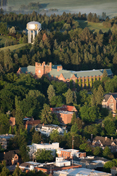Glacier Races to the Sea—U of I Geoscientists Race to Understand Why!
University of Idaho geoscientists are launching a three-year project aimed at addressing one of Earth science’s most pressing societal questions: How fast will the oceans rise during the coming decades and centuries?
The global ocean is currently rising at the rate of 1 foot per century. Whether we expect sea level rise to continue at that rate — or speed toward 4 or 5 feet of new coastal flooding per century — depends significantly on how and why glaciers and ice sheets speed up.
To better understand glacier speed-up, Professor Timothy Bartholomaus is mentoring University of Idaho students and collaborating with scientists at other Idaho universities. A new, $1.4 million project, supported by the U.S. National Science Foundation, will allow Bartholomaus and others to learn what controls abrupt accelerations of glacier flow known as glacier surges.
In August 2020, the team visited their target surging glacier in the heart of North America’s iciest mountain range and set up a comprehensive set of geophysical instruments to track glacier motion and water flow at the bottom of the glacier. The team found the glacier had sped up 20-fold in a matter of months.
Measurements will continue as the surge begins to wane. The researchers will synthesize observations with theory to better understand how much — and under what circumstances — Greenland and Antarctic ice can race to the sea.






